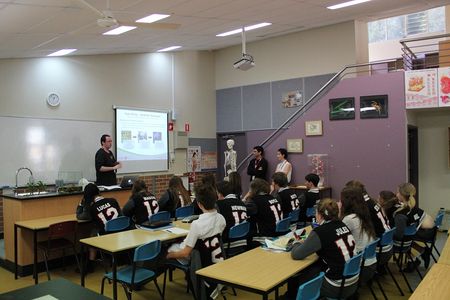Team:Macquarie Australia/Protocols/tour
From 2012.igem.org
A Quick Flick of The Switch
The Macquarie Project
Being able to induce gene expression is one of the most important aspects of the biomolecular sciences. It allows us to determine the role of specific genes and to produce them in vast quantities. Chemical induction is commonly used but has some lag time and so is less useful to determine the role of a developmental gene. As such a fast and reversible method of controlling gene expression needs to be developed, one that does not require a long incubation time. Our project aims to produce a light controlled gene switch by coupling heme oxygenase with a bacteriophytochrome. To achieve this goal we will be using Gibson Assembly.
To truly embrace synthetic biology and modify genes to suit our need we have utilised Gibson Assembly. This allows us to introduce numerous changes to the gene of interest. Our project is a showcase for the power of Gibson Assembly in Synthetic Biology. By starting with an a natural gene and optimising it for E. coli we will show how useful Gibson Assembly is for altering the gene but maintaining the same function.
The Light Switch
To be able to control gene expression with light, the Macquarie Team has produced a switch capable of self assembly. Bacteriophytochromes are known to be able to control gene expression based on the availability and intensity of light. The bacteriophytochrome requires biliverdin to to harvest light and cause the activation of different metabolic pathways. E. coli is unable to produce this and so the Macquarie team has provided the cell with this gene as well. This allows for the cell to assemble the light switch without the external introduction of biliverdin.
Significant Results
The light switch was shown to self assemble after incubation with ALA (5-aminolevulinic acid) and IPTG. The cell was able to successfully produce biliverdin which was shown to couple with the bacteriophytochrome. Bacteriophytochromes are IR inactive and biliverdin is IR active. As such biliverdin bound to the bacteriophytochrome would IR active. This was observed in the infrared imaging of an SDS-PAGE gel. This provides the first evidence of a Deinococcus bacteriophytochrome being coupled with the heme oxygenase product.

Human Practice and Outreach
As part of our participation in iGEM, we strongly supported the concept of human practice and as part of this raised awareness of the ethical concerns surrounding Synthetic Biology. To achieve this we took a two pronged approach-
- To approach a High School Biology class (our specialised audience)
- To present at our University's open day (our general audience)
As part of our school visit we introduced the students to the ethical concerns surrounding synthetic biology. Different case studies were examined and ways of alleviating the ethical issues were determined. We believe that this is an important aspect of synthetic biology and iGEM and so spent considerable time working and planning this. For more information on our views on synthetic biology and education are detailed here.
For our general audience we ran displays of lab activities. Our goal was to simplify the procedures and remove any negative connotations Synthetic Biology had. We did this by clarifying misconceptions and general communications with people from the wider community.
 "
"






